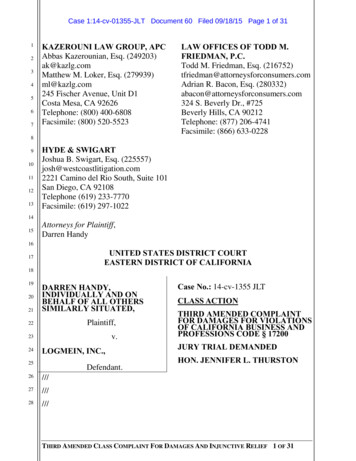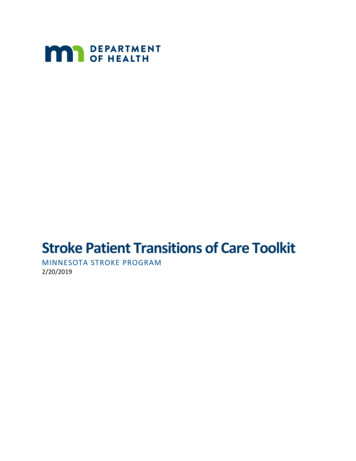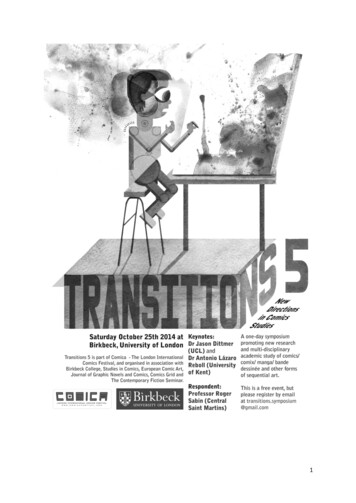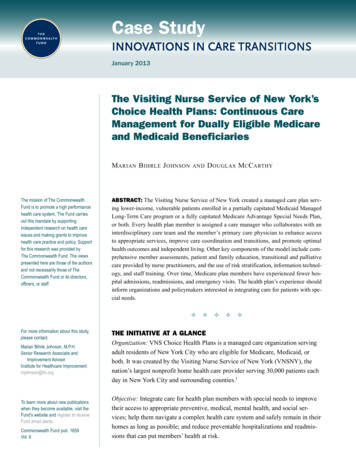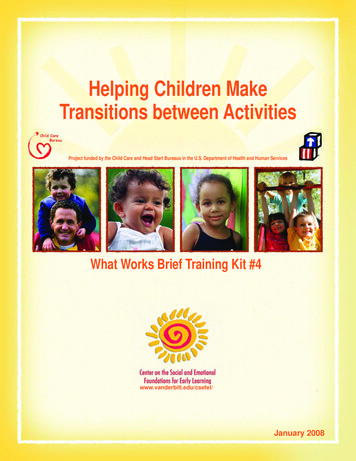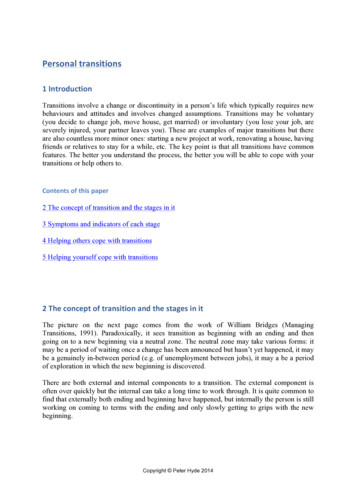
Transcription
Personaltransitions1IntroductionTransitions involve a change or discontinuity in a person’s life which typically requires newbehaviours and attitudes and involves changed assumptions. Transitions may be voluntary(you decide to change job, move house, get married) or involuntary (you lose your job, areseverely injured, your partner leaves you). These are examples of major transitions but thereare also countless more minor ones: starting a new project at work, renovating a house, havingfriends or relatives to stay for a while, etc. The key point is that all transitions have commonfeatures. The better you understand the process, the better you will be able to cope with yourtransitions or help others to.Contentsofthispaper2 The concept of transition and the stages in it3 Symptoms and indicators of each stage4 Helping others cope with transitions5 Helping yourself cope with The picture on the next page comes from the work of William Bridges (ManagingTransitions, 1991). Paradoxically, it sees transition as beginning with an ending and thengoing on to a new beginning via a neutral zone. The neutral zone may take various forms: itmay be a period of waiting once a change has been announced but hasn’t yet happened, it maybe a genuinely in-between period (e.g. of unemployment between jobs), it may a be a periodof exploration in which the new beginning is discovered.There are both external and internal components to a transition. The external component isoften over quickly but the internal can take a long time to work through. It is quite common tofind that externally both ending and beginning have happened, but internally the person is stillworking on coming to terms with the ending and only slowly getting to grips with the newbeginning.Copyright Peter Hyde 2014
itionPeople going through change experience a variety of emotional states. Transitions typicallypass through the cycle of reasonably predictable phases described below. In each case it issuggested that it will be necessary to work through all of the stages if the transition is to besuccessfully completed.The model presented below has been developed by John Hayes and Peter Hyde from theversion which originally appeared in an article by Barrie Hopson and John Adams called“Towards an understanding of transition”, published in Transitions: Understanding andmanaging personal change by John Adams, John Hayes and Barrie Hopson (MartinRobertson, 1976).The cycle reflects variations in the degree to which we feel able to exercise control over thesituation.Transition phasesMoodDenialShockInternalisationReflection &learningDepressionConsolidationTestingLetting goAcceptance of realityTimePage 2
ShockThe initial phase of a transition is experienced by many people as a state of shock: of beingoverwhelmed, frozen, paralysed, unable to reason, plan or act. There may be an initialexpression of grief, anger or euphoria - hence the mood curve may go up or down. Theintensity of this phase will be influenced by the degree of preparedness and the desirability ofthe transition - it will be greater for an unexpected, undesirable change.DenialThis phase is characterised by a retreat from the reality of the change. Negative changes maybe denied or trivialised and attention may be displaced onto other more immediate but lessimportant matters. Energy and activity are devoted to the known and the familiar. Positivechanges may induce euphoria and an unwillingness to consider any possible negativeconsequences. Denial may be highly functional if it provides time to retreat from the reality ofa crisis and allow our internal forces to regroup to later face the challenge. However, ifmaintained for long, denial inhibits the ability to deal with the reality of a change.DepressionEventually the reality of the change becomes apparent and this often provokes a feeling ofdepression. This is associated with feeling that the situation is beyond one’s control. Thephase may be characterised by anger, sadness, withdrawal and confusion. This drop in moodoccurs even in changes which were initially embraced enthusiastically when the practicaldifficulties are faced. It is in the depression phase therefore that the change really starts to beexperienced as stressful. If the change was a voluntary one, this may be the point at which theperson gives up. In involuntary changes, the person may seek to leave the situation.LettinggoThis phase involves accepting reality for what it is. It implies a clear letting go of the presentor past. This may be experienced as a “little death” and often entails a process of mourning. Itcan help at this point to remember that the lowest ebb is the turn of the tide.TestingA more active, creative, experimental involvement in the new situation starts to take place.New ways of behaving and being are tried out. More energy is available but anger andirritability may be easily aroused if the new behaviour is not successful. This phase mayinvolve trial-and-error behaviour or a more active cycle of experience-review-conclude-planmay be employed. As some patterns are found which seem to work, this phase gradually givesway to the next.ConsolidationOut of the testing process come some new ways of being and behaving which are graduallyadopted as new norms.Page 3
ReflectionandlearningThis is a more cognitive process involving reflecting on what all the activity and emotion hasreally meant. It is at this point that learning and personal growth from change may becomeapparent, which may benefit future n)The transition is complete when the changed behaviour is now normal and unthinking and isthe new natural order of things. Ideally the past has been left behind to an appropriate extentand no “unfinished business” remains.CommentsEach individual’s experience of a transition will be influenced by a number of factorsincluding the importance of the transition, the intensity of its impact, the existence of othersimultaneous transitions, personal resilience etc. It follows therefore that there can be noabsolutely standard path through it. Some possible variations are noted below: The wave can be shallower or deeper and the overall shape of the curve may be skewedone way or the other. The time taken to pass through all the phases varies greatly. Although presented as purely linear process, regression may occur, people may slip backto an earlier stage in the process. People can get stuck at any phase, but especially denial or the depression phase and notcomplete the cycle.Where multiple transitions are involved, people handle the situation in different ways. Somepeople keep the transitions firmly compartmentalised and deal with one at a time; othersthrow their energy into one as a displacement activity to get away from another (which istherefore held in denial); in other cases, one major transition predominates and swamps theothers. There is no right way but it seems clear that that for each transition all stages of thecycle must be successfully accomplished.ImplicationsForindividuals It takes time to make the adjustments required in transitions. It can help to know that one’s own experience is normal and will eventually come to anend. It helps to accept that there will be ups and downs.Page 4
The process can be managed: there are things you can do to facilitate you own passagethrough it. Only you can gtohelpothers It is important to recognise that there will often be a time lag between the announcementof a change and an emotional reaction to it: it is easy to mistake the apparent calm of theshock and denial phases for acceptance of the change. Different parts of an organisation will progress through the cycle at different rates and indifferent ways. Beware of getting out of phase with your staff - it is normal for managers or initiators tohave reached an acceptance of change long before staff have and this creates greatpotential for ineffective communication. The cycle cannot be avoided, but there is much that you can do to facilitate people’spassage through it.3SymptomsandindicatorsofeachstageThe model of personal transitions suggests that everyone goes through the same sequence ofstages. However, it is also clear that there are wide individual variations in the rate ofprogression through these stages. In order to be able to help yourself or to help others youneed to be able to diagnose where they are in the process. This section outlines the kinds ofverbal and behavioural indicators which may be seen at each stage.ShockThere may be an initial outpouring of emotion, but the essence of the shock stage is numbnessand paralysis. The indications therefore are: Stillness and absence of energy. Going through the motions - “robotic” behaviour. Inability to reason or plan. Lack of response to external stimuli.Denial Inappropriate cheerfulness or optimism.Page 5
Energy devoted to unimportant tasks. Clutching at straws. “It will never happen.” “It won’t affect me.”DepressionThe typical manifestations of this stage are: anger, sadness, confusion and withdrawal.AngerAnger involves the recognition that what once was is no more. In particular, something whichwas valued has been lost - or more often, taken away. It is often associated with feeling apowerless victim of change. Anger may be expressed directly - in which case it is probablyeasier to deal with - or may be suppressed and come out in more indirect ways. Possiblemanifestations: Sarcasm and destructive criticism. Sabotage. Flare ups at slight provocation. Irritability and friction. “It’s not fair.” “It’ll never work.”SadnessThis occurs when something which the person identifies with and values has been removed(e.g. specific tasks, location, colleagues, expertise) and there seems to be nothing equivalentto replace it with. It is basically about hanging on to the past and is often coupled with adistorted view of the future. Dwelling on the past. Seeing the future in the worst possible light. Scaremongering. Tearful outbursts. “I used to be .”Page 6
WithdrawalThis involves reacting to a change by refusing to engage with it or by actually ormetaphorically running away. Loss of interest, drive and enthusiasm (“quit and stay”). Quitting, request for transfer, early retirement. Illness, absenteeism. Unwilling to become involved or seek out information. “Anything you say.”ConfusionThis happens when people have trouble making sense of the new order of things. They losesight of where they fit in and what they should be doing. The main symptom is: Compulsive hunger for information coupled with a failure to take the information in.The characteristic information hunger should not be taken entirely at face value. Change willalways generate a need for information, but what distinguishes disorientation is itscompulsive quality coupled with a failure to really take in the information when it is provided.It can best be understood as indicating difficulty in letting go of the old order, attachment towhich is blocking the reception and understanding of new information. Another possibleinterpretation is that the person simply does not believe the information which is provided.LettinggoSigns which indicate that someone is having difficulty letting go: Constantly talking about the past. Associating mainly with old colleagues or in old locations. Resolutely using old names, concepts and language. Asides, “jokes” and put-downs. Seeking to form a “fed up club”.Signs which indicate that someone is beginning to let go: Talking about the future rather than the past. Identifying new possibilities that might deserve further attention.Page 7
TestingThe normal signs of this stage are: Gathering information about new possibilities. Taking risks. Experimenting with new behaviours. Mood swings from enthusiasm to discouragement.The main sign of being stuck here is: Completely random and erratic behaviour (i.e. no sign of consolidation).ConsolidationThis stages occurs alongside the testing one and gradually supersedes it. It is characterised by: Thinking and talking about the positive and negative aspects of new experiences anddrawing conclusions. Developing a more concrete picture of the future and a realistic assessment of what needsto be done to make it a reality. Recognising and staying with a role, relationship or behaviour which seems to worksatisfactorily. An increasing degree of predictability and stability in behaviour.The main problem indicator is: Premature closure: one new pattern of behaviour is seized on as the salvation and testingstops too soon, before it is established whether there might be an even better option.ReviewThis stage is characterised by: Reflecting back over the whole experience of change. Identifying actions which might help one cope more effectively with future changes.The danger sign here is: Giving way to regret and recrimination.Page 8
4HelpingotherscopewithtransitionsThis is particularly important where people have become stuck at a particular stage in theprocess. Possible actions are presented in relation to the stages of the process of transition.Announcement/shockSometimes the shock reaction can be minimised by: Preparing the ground and creating a climate of receptivity to change. Consulting and involving people in the decision making.If this is not possible, the announcement will work best if you: Choose the most appropriate person to make the announcement. Do it face to face, if possible. Keep it simple. Show empathy and understanding for how people will feel. Are open about your own feelings. Say something about feelings before going in with the facts. (E.g. “I know this will beupsetting for you and I feel very sad about it myself, but .”) Invite reactions and questions. Emphasise why the change is necessary. Keep calm and do not become defensive or aggressive in the face of questions. Allow time for people to digest the information and share their feelings. Ensure a consistent message is given to all. Where possible, ensure simultaneous announcement.When people are in shock: Recognise the likely temporary performance impairment. Offer support, especially company.Page 9
DenialFirst diagnose what is being denied (e.g. the change wasn’t necessary, is not real, won’thappen, or does not affect them). Possible actions then: Confront what is being denied gently and supportively. Repeat the message. Draw people’s attention to relevant examples, evidence and experience. Arrange demonstrations if possible. Establish and keep to a timetable to provide milestones and evidence of change. Make it inescapable for them to engage with the reality of the change. Take early action if at all possible. Get people to do practical things related to the uation: Provide support. Listen. Accepting and non-critical reaction to expressions of ion: Help them get it off their chest. Provide space to grieve. Provide appropriate opportunities to vent emotion.Helpthemidentifyopportunitiestomoveon: Don’t let them wallow in feeling bad: gently confront and challenge. Help them identify other things they are good at. Provide further information about the change to help people envisage what the future willbe like.Page 10
Help them identify options and possible benefits. Help them focus their attention on the things they can do or can influence. Where possible, provide opportunities for the exercise of influence (e.g. consultation andinvolvement).Lettinggo Avoid rubbishing the past while focusing on the need to change. Challenge. Draw attention to deadlines. Eliminate the symbols of the past. Reminisce leading to a process of taking the best forward from the past. Mark the ending by rituals and ceremonies, wakes and leaving parties. Let people take souvenirs and mementoes.Testing Create the space, time and resources required to test. Promote creative thinking. Help identify options. Encourage risk and experimentation. Discourage premature closure. Don’t punish mistakes. Inject new processes, tools and competencies that will help people help themselves. Eliminate the drivers of old behaviours. Act as a mentor. Praise and support successes. Encourage networking and cross fertilisation.Page 11
Provide feedback.Consolidation Review performance and learning. Help identify characteristics of a more desirable state. Recognise and reward achievement. Get them to help others, share experience. Help build on successes. Broadcast successes.Reflectionandlearning Help them review the experience of change - ask questions, run review workshops. Formal Post Implementation Review. Get them to help others, share experience.Internalisation Switch to more of a task focus. Withdraw somewhat from the helping role.5HelpingyourselfcopewithtransitionsAll change involves both threat and opportunity and active self-management will increase thechance of growth and satisfaction and reduce the risk of stress-induced illness. The strategiesdescribed here can apply throughout the process.Self- ‐awareness Take time out to review and reflect on what is happening to you. Be aware of how you are feeling and coping. Distinguish between current losses and old wounds.Page 12
Make sense of your experience in the light of your understanding of the normal process ofchange.BeclearaboutwhatyouwantIf the transition was one you initiated yourself, the more clearly you have defined your goalsthe easier it will be to manage. You can plan, measure progress, feel a sense ofaccomplishment, etc.If the transition was imposed, it still helps to be clear about where you stand in relation to it.There are basically only four choices: Resist – this can be the right course of action and may work, but it can also represent aform of denial. Refuse to accept it, although this is a guaranteed way to prolong the bad feelings Accept it grudgingly, put up with it - this can be a way to survive Accept it and seek to benefit or at least make the best of it - in this way growth may takeplace.FormaclearandrealisticviewofthefutureIn order to prepare for a transition and plan your own course of action you need to have aclear idea of what it will mean. This essentially means collecting information about thechange by actively seeking it and by asking questions and also trying to think through what itwill be like and what the implications will be. Part of this is being clear about what is or willbe ending.The main problem with this simple rational process is fear and anxiety about what the futurewill hold. Fear may block us from any attempt to imagine what it will be like or may lead usto exaggerate the difficulties and the consequences.“Being positive” is often advanced as the antidote to this state of affairs, but beingunthinkingly positive may easily be self-defeating if it blinds you to the real needs of thesituation. More helpful is to form a realistic appraisal of what is involved. First ask yourself(or even better, get someone else to ask you): “What am I telling myself about this change?”Then do a reality check using one or more of the processes listed below.Measure the extent or difficultyWhat do you really have to do? Often writing it down makes the inner list seem much moremanageable. What really has to be done by the deadline? How much will really change? Howmany new forms and procedures will there really be? And so on.Rate the difficultyPage 13
How difficult is your task really. Rate it on a scale of 0 to 10. Often, things which were seenas overwhelmingly hard are suddenly rationally assessed at only 6 or 7.Rate your abilityHave you ever encountered anything like this in the past? How did you cope then? What skillsand abilities did you use? How does this challenge look now?Imagine the worseSometimes of course a mountain really is a mountain. Then the question to ask is, “Whatreally is the worst that could happen?” Having confronted this, then consider how likely it isand how you would react.FocusonwhatyoucandoSome things are wholly within our own ability to control (many aspects - some would say all- of our own behaviour); others we cannot control but can influence (most obviously thebehaviour of other people); and others again are wholly outside our control and we musttherefore adapt to. A helpful way of visualising this is through the idea of circles of influence.Circles of influenceCancontrolCan influenceMust adapt toThe final outcome in most organisational changes and in relation to most personal goals doesindeed often depend on external factors. Focusing on these in situations of change is all tooeasy, but it is also a recipe for anger, depression and frustration and is essentially a waste oftime. Much more effective is to focus on the things which are under your own control andinfluence and ask what you can do now about those things e.g. by actively seekinginvolvement in the change.Page 14
LookafteryourselfTransitions are inherently stressful. You therefore need to look after yourself to maintainresilience and to speed recovery. The main areas under this heading are: Healthy diet. Sufficient exercise. Enough sleep. Give yourself treats and rewards. Learn to relax. Find some fixed reference points (another role, a person, a routine, a place etc.) to hang onto in the midst of turbulence.SeeksupportThe main problems of transition are rooted in the emotional reactions which we go through.What helps most in dealing with these is talking to other people about how we are feeling.Other people can support us by providing: An opportunity to vent emotion . Sympathy. Reassurance. Information. Alternative ways of looking at things. Challenge. Confirmation of our worth. Help in clarification and reality checking.LearnfromtheexperienceConsciously fostering our own learning will speed up the process of mastering a transitionand also make the next transition easier. The learning cycle below describes the process bywhich we learn from experience.Page 15
The learning cycleExperiencePlan futurebehaviourObserveand reviewFormgeneralisationsThe model suggests that we go through a series of stages which are endlessly repeated. Wehave experiences, observe or reflect on what happens, form generalisations on the basis of ourobservation and test these out initially by planning to behave differently next time.However, it is said that some people have a thousand experiences while others have the sameexperience a thousand times. If the subsequent stages do not occur, the model indicatesclearly enough how we can fail to learn from experience. This may mean that we areunsuccessful but do not know why we have failed or that we are successful but do not knowwhat we did right and are therefore unable to transfer the skill to new situations or to teachothers.Some of the main implications of the learning cycle are: You can enter the cycle at any point, but if learning is to be maximised, the whole cyclemust be completed. People will only learn a skill if they have opportunities to practice that skill. Practice is of little use unless there is feedback, either from the task itself, by self analysisor from observation by others. Learning is increased the more times one goes round the cycle. (This does not mean thatthe whole experience or task has to be repeated - it is frequently enough to repeat the partmost in need of improvement.)LearningfromhardknocksPerhaps the main weakness of the learning cycle concept is that it is excessively rational.Where the experience to be learned from was of failure or rejection there seems to be animportant emotional process involved which determines what if anything is learned. There arethree main stages:Page 16
1. Enduring the blow and not being flattened or overwhelmed by it.2. Coping with the pain. This is usually best done by private catharsis (i.e. letting out theanger, grief or whatever). It is important, if learning is to take place, not to give in toaggressive or self destructive urges.3. Accepting some level of ownership of what happened. This does not mean accepting that itwas all your fault, but rather recognising that you could have behaved differently and that,if you had, it would have had some effect on the outcome. If this stage does not takeplace, responsibility for the experience remains wholly external and nothing personal canbe learned. Sometimes, of course, responsibility for what happened does lie wholly withsomeone else or some outside agency and in that case it can be quite appropriate for thereto be nothing to learn.Page 17
The picture on the next page comes from the work of William Bridges (Managing Transitions, 1991). Paradoxically, it sees transition as beginning with an ending and then going on to a new beginning via a neutral zone. The neutral zone may take various forms: it may be a period of waiting onc
